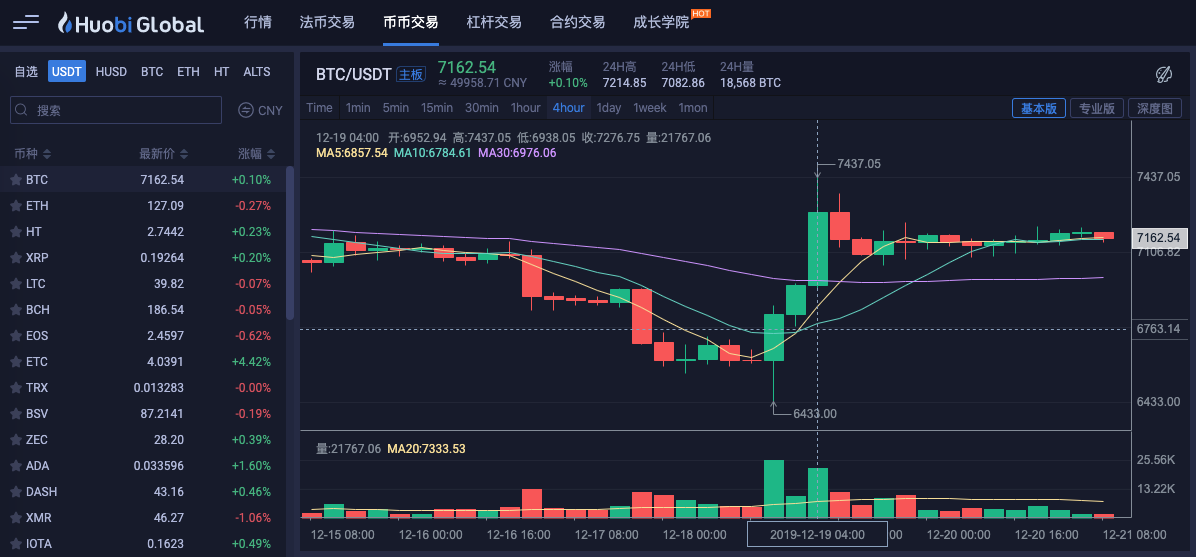हाथ से हाथ मिलाकर आप एक पायथन संस्करण के लिए एक के-लाइन संश्लेषण फ़ंक्शन लिखने के लिए सिखाया
लेखक:आविष्कारक मात्रा - छोटे सपने, बनाया गयाः 2019-12-21 09:38:26, अद्यतन किया गयाः 2024-12-15 15:59:54
हाथ से हाथ मिलाकर आप एक पायथन संस्करण के लिए एक के-लाइन संश्लेषण फ़ंक्शन लिखने के लिए सिखाया
नीति लेखन में अक्सर कुछ असामान्य K-लाइन चक्र डेटा का उपयोग किया जाता है; हालांकि, एक्सचेंजों और डेटा स्रोतों ने इन चक्रों का डेटा प्रदान नहीं किया है; केवल पहले से ही चक्र वाले डेटा का उपयोग करके संश्लेषण किया जा सकता है। संश्लेषण एल्गोरिथ्म पहले से ही जावास्क्रिप्ट संस्करण है।लिंक) वास्तव में जावास्क्रिप्ट कोड के एक टुकड़े को पायथन संस्करण में स्थानांतरित करना बहुत आसान है. इसके बाद हम एक पायथन संस्करण के लिए एक के-लाइन सिंथेटिक एल्गोरिथ्म लिखेंगे.
जावास्क्रिप्ट संस्करण
function GetNewCycleRecords (sourceRecords, targetCycle) { // K线合成函数
var ret = []
// 首先获取源K线数据的周期
if (!sourceRecords || sourceRecords.length < 2) {
return null
}
var sourceLen = sourceRecords.length
var sourceCycle = sourceRecords[sourceLen - 1].Time - sourceRecords[sourceLen - 2].Time
if (targetCycle % sourceCycle != 0) {
Log("targetCycle:", targetCycle)
Log("sourceCycle:", sourceCycle)
throw "targetCycle is not an integral multiple of sourceCycle."
}
if ((1000 * 60 * 60) % targetCycle != 0 && (1000 * 60 * 60 * 24) % targetCycle != 0) {
Log("targetCycle:", targetCycle)
Log("sourceCycle:", sourceCycle)
Log((1000 * 60 * 60) % targetCycle, (1000 * 60 * 60 * 24) % targetCycle)
throw "targetCycle cannot complete the cycle."
}
var multiple = targetCycle / sourceCycle
var isBegin = false
var count = 0
var high = 0
var low = 0
var open = 0
var close = 0
var time = 0
var vol = 0
for (var i = 0 ; i < sourceLen ; i++) {
// 获取 时区偏移数值
var d = new Date()
var n = d.getTimezoneOffset()
if (((1000 * 60 * 60 * 24) - sourceRecords[i].Time % (1000 * 60 * 60 * 24) + (n * 1000 * 60)) % targetCycle == 0) {
isBegin = true
}
if (isBegin) {
if (count == 0) {
high = sourceRecords[i].High
low = sourceRecords[i].Low
open = sourceRecords[i].Open
close = sourceRecords[i].Close
time = sourceRecords[i].Time
vol = sourceRecords[i].Volume
count++
} else if (count < multiple) {
high = Math.max(high, sourceRecords[i].High)
low = Math.min(low, sourceRecords[i].Low)
close = sourceRecords[i].Close
vol += sourceRecords[i].Volume
count++
}
if (count == multiple || i == sourceLen - 1) {
ret.push({
High : high,
Low : low,
Open : open,
Close : close,
Time : time,
Volume : vol,
})
count = 0
}
}
}
return ret
}
एक जावास्क्रिप्ट एल्गोरिथ्म है, जो कि पायथन के लिए पंक्ति-दर-पंक्ति अनुवाद पोर्ट करने में सक्षम है, जो कि जावास्क्रिप्ट के अंतर्निहित कार्यों या अंतर्निहित तरीकों से मिलता है, जो कि पायथन में संबंधित खोज करने के लिए उपयुक्त हैं, इसलिए पोर्ट करना अपेक्षाकृत आसान है।
एल्गोरिथ्म का तर्क बिल्कुल समान है, केवल जावास्क्रिप्ट में फ़ंक्शन कॉलvar n = d.getTimezoneOffset()और जब आप इसे Python में ले जाते हैं, तो आप Python के टाइम रिपॉजिटरी का उपयोग करते हैं।n = time.altzoneइसके बजाय; अन्य अंतर केवल भाषा के वाक्यविन्यास के पहलू हैं (जैसे कि for चक्र का उपयोग, बुल मान का अंतर, तर्क और, तर्कहीन, तर्क या के उपयोग का अंतर आदि) ।
पायथन कोड के बाद ट्रांसप्लांट किया गयाः
import time
def GetNewCycleRecords(sourceRecords, targetCycle):
ret = []
# 首先获取源K线数据的周期
if not sourceRecords or len(sourceRecords) < 2 :
return None
sourceLen = len(sourceRecords)
sourceCycle = sourceRecords[-1]["Time"] - sourceRecords[-2]["Time"]
if targetCycle % sourceCycle != 0 :
Log("targetCycle:", targetCycle)
Log("sourceCycle:", sourceCycle)
raise "targetCycle is not an integral multiple of sourceCycle."
if (1000 * 60 * 60) % targetCycle != 0 and (1000 * 60 * 60 * 24) % targetCycle != 0 :
Log("targetCycle:", targetCycle)
Log("sourceCycle:", sourceCycle)
Log((1000 * 60 * 60) % targetCycle, (1000 * 60 * 60 * 24) % targetCycle)
raise "targetCycle cannot complete the cycle."
multiple = targetCycle / sourceCycle
isBegin = False
count = 0
barHigh = 0
barLow = 0
barOpen = 0
barClose = 0
barTime = 0
barVol = 0
for i in range(sourceLen) :
# 获取时区偏移数值
n = time.altzone
if ((1000 * 60 * 60 * 24) - (sourceRecords[i]["Time"] * 1000) % (1000 * 60 * 60 * 24) + (n * 1000)) % targetCycle == 0 :
isBegin = True
if isBegin :
if count == 0 :
barHigh = sourceRecords[i]["High"]
barLow = sourceRecords[i]["Low"]
barOpen = sourceRecords[i]["Open"]
barClose = sourceRecords[i]["Close"]
barTime = sourceRecords[i]["Time"]
barVol = sourceRecords[i]["Volume"]
count += 1
elif count < multiple :
barHigh = max(barHigh, sourceRecords[i]["High"])
barLow = min(barLow, sourceRecords[i]["Low"])
barClose = sourceRecords[i]["Close"]
barVol += sourceRecords[i]["Volume"]
count += 1
if count == multiple or i == sourceLen - 1 :
ret.append({
"High" : barHigh,
"Low" : barLow,
"Open" : barOpen,
"Close" : barClose,
"Time" : barTime,
"Volume" : barVol,
})
count = 0
return ret
# 测试
def main():
while True:
r = exchange.GetRecords()
r2 = GetNewCycleRecords(r, 1000 * 60 * 60 * 4)
ext.PlotRecords(r2, "r2")
Sleep(1000)
परीक्षण
सिक्का बाजार चार्ट
चार घंटे के चार्ट का पुनर्मूल्यांकन
उपरोक्त कोड केवल सीखने के संदर्भ के रूप में उपयोग किया जाता है, यदि किसी विशेष रणनीति में उपयोग किया जाता है, तो आवश्यकता के अनुसार संशोधित या परीक्षण करें। अगर आपको कोई बग या सुधार सुझाव है, तो कृपया टिप्पणी करें, बहुत बहुत धन्यवाद o^_^o
- डीईएक्स एक्सचेंजों का मात्रात्मक अभ्यास (2) -- हाइपरलिक्विड यूजर गाइड
- DEX एक्सचेंज क्वांटिफाइंग प्रैक्टिस ((2) -- हाइपरलिक्विड उपयोग गाइड
- डीईएक्स एक्सचेंजों का मात्रात्मक अभ्यास (1) -- dYdX v4 उपयोगकर्ता गाइड
- क्रिप्टोकरेंसी में लीड-लैग आर्बिट्रेज का परिचय (3)
- DEX एक्सचेंज क्वांटिफाइड प्रैक्टिस ((1)-- dYdX v4 उपयोग गाइड
- डिजिटल मुद्रा में लीड-लैग सूट का परिचय (3)
- क्रिप्टोकरेंसी में लीड-लैग आर्बिट्रेज का परिचय (2)
- डिजिटल मुद्राओं में लीड-लैग सूट का परिचय (2)
- एफएमजेड प्लेटफॉर्म के बाहरी सिग्नल रिसेप्शन पर चर्चाः रणनीति में अंतर्निहित एचटीपी सेवा के साथ सिग्नल प्राप्त करने के लिए एक पूर्ण समाधान
- एफएमजेड प्लेटफॉर्म के लिए बाहरी सिग्नल प्राप्त करने का अन्वेषणः रणनीति अंतर्निहित एचटीटीपी सेवा के लिए सिग्नल प्राप्त करने के लिए पूर्ण समाधान
- क्रिप्टोकरेंसी में लीड-लैग आर्बिट्रेज का परिचय (1)
- मात्रात्मक विखंडन दर व्यापार रणनीति
- पायथन प्लेटफ़ॉर्म संतुलन रणनीति
- बूढ़े किसान का गड्ढे पर चढ़ने का सफर
- 95 के बाद के सिक्कों के मालिक की कहानी
- हाथ से हाथ मिलाकर आपको सिखाया जाता है कि आप एक ही प्रकार की नीति को कई प्रकार की नीति में कैसे बदल सकते हैं।
- मेरे ऑटोमेशन के नुकसान और एफएमजेड की यात्रा
- एफएमजेड हृदय पथ यात्रा - कूदने की रणनीति के साथ
- पायथन संस्करण के पीछे की रणनीति
- पायथन संस्करण सरल ग्रिड रणनीति
- डिजिटल मुद्रा विकल्पों के लिए एक अनबॉक्स क्वांटिफाइड ट्रेडिंग टूल
- हाथ जोड़ने के लिए आपको सिखाता है कि कैसे रणनीति में अधिक चार्ट समर्थन जोड़ें
- डेटा प्लेबैक सुविधाओं के आधार पर विकसित रैखिक लटकन एकल प्रवाह रणनीति
- हाथ से हाथ मिलाकर आपको एक मैक भाषा रणनीति (प्रगति) ट्रांसप्लांट करना सिखाता है।
- डिजिटल मुद्राओं की मात्रा में लेनदेन के बारे में जानकारी
- आविष्कारक FMex खनन रणनीति का उपयोग करने के लिए गाइड
- ब्लॉकचेन परिसंपत्ति मात्रा में लेनदेन में अंतर-मुद्रा प्रतिभूति रणनीति
- विकल्प परिमाणात्मक लेनदेन के लिए डेरिबिट फ्यूचर्स एपीआई को संशोधित किया गया
- हाथ से हाथ मिलाकर आपको रणनीति लिखना सिखाया जाता है -- एक My Language रणनीति को ट्रांसप्लांट करना।
- त्रिभुज हेजिंग के विवरण का विश्लेषण करने के लिए अनुसंधान परिवेश का उपयोग करें और हेजिंग मूल्य पर प्रसंस्करण शुल्क का प्रभाव
- एफएमजेड क्वांट डेटा साइंस अनुसंधान वातावरण का परिचय
उपदेश/upload/asset/30da6ebb64b8003b1686.jpg हा हा, ड्रीम ड्रीम टीचर मेरे से ज्यादा टेक्निकल है. स्क्रीनशॉट ड्रीम ड्रीम टीचर को संदर्भ दें.
उपदेशpyresample फ़ंक्शन का उपयोग करके एक पंक्ति में हल किया गया है।
आविष्कारक मात्रा - छोटे सपनेज़ान, मैं पायथन नहीं कर सकता, मैं अभी शुरुआत कर रहा हूँ।
आविष्कारक मात्रा - छोटे सपने666 सीख रहा है।